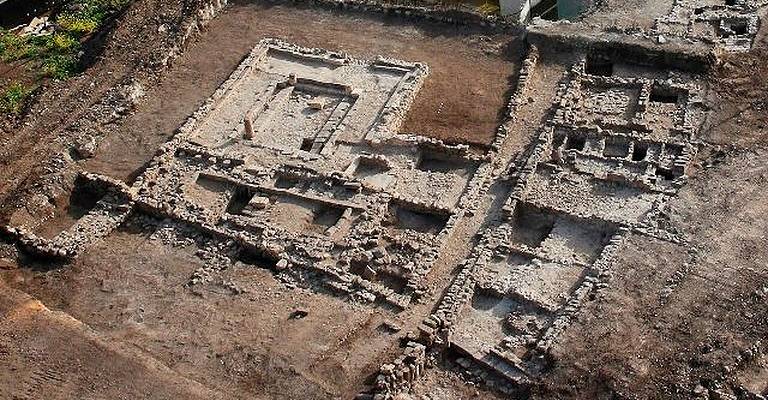The Jewish nature of Palestine – historically, nationally, culturally and religiously – is documented by a multitude of archaeological findings, mostly in the mountain ridges of Judea and Samaria, which are the cradle of Judaism, the Jewish people and the Jewish State.
By Amb. (ret.) Yoram Ettinger, “Second Thought: a US-Israel Initiative”
The Palestinian leadership is rehashing the notion that Palestine has been Arab/Muslim from time immemorial. But, is such a claim consistent with historic documentation?
According to Brown University Prof. David Jacobson, “the Greek Palaistine and the Latin [Rome] Palaestina… appear to refer not to the Land of the Philistines [Pleshet in Hebrew], but to the Land of Israel…. The Philistines [Plishtim in Hebrew] arrived on the eastern coast of the Mediterranean from Greece or Cyprus in approximately the 13th century BCE…. The Israelites’ traditional foes, the Philistines lived in a small area along the Mediterranean coast south of what is today Tel Aviv, an area that embraced the five towns of Gaza [hometown of Delilah], Ashdod, Ashkelon, Gath [hometown of Goliath] and Ekron….
“As early as the Histories of Herodotus [the Greek founding father of Western historians] written in the second half of the 5th century BCE, the term Palaistine is used to describe not just the [Philistines’] geographical area, but the entire area between Phoenicia and Egypt – in other words, the Land of Israel [including the Judean Hills, referred to by some as the ‘West Bank’]…. Like Herodotus, Aristotle [along with his teacher, Plato, the founding fathers of Western philosophers] gives the strong impression that when he uses the term Palestine, he is referring to the Land of Israel…. In the 2nd century BCE, a Greek writer and historian Polemo of Ilium made a similar link between the people of Israel and Palestine….
“The early 1st century Roman poet, Ovid, writes of ‘the seventh day feast [the Sabbath] that the Syrians of Palestine [the Hebrews] observe….’ Another Latin poet, Statius, and the writer Dio Chrysostom use ‘Palestine’ and ‘Palestinian’ in the same sense….
“Likewise the early 1st century CE Jewish philosopher, Philo of Alexandria, occasionally, uses the name Palestine when referring to the Land of Israel….
“’Palestine’ is the Greek equivalent of ‘Israel.’” The Greek word ‘Palaistine’ is remarkably similar to the Greek ‘Palaistes’, meaning ‘wrestler’…. The name ‘Israel’ arose from the incident in which Jacob [the Patriarch] wrestled with an angel (Genesis 32-25-27). Jacob received the name Israel because he wrestled successfully (sarita’ in Hebrew) with the Lord (El in Hebrew)….
“The striking similarity between the Greek word for wrestler (palaistes) and the name Palaistine – which share seven letters in a row, including a diphthong – is strong evidence of a connection between them…. The central event of a wrestling contest by the ancestor of this Semitic people against a divine adversary is likely to have made a deep impression on the Greeks [who admired wrestling, which took place in structures called ‘palaestra’]….”
Judea Syria-Palaestina
The Roman Emperor, Hadrian, officially renamed Judea Syria-Palaestina after his Roman armies suppressed the [Jewish] Bar-Kokhba Revolt in 135 CE. This is commonly viewed as a move intended to sever the connection of the Jews to their historic homeland. However, that Jewish writers such as Philo and Josephus used the name Palestine for the Land of Israel in their Greek works, suggests that this interpretation of history is incorrect.
Hadrian’s choice of Syria-Palaestina may be more correctly seen as a rationalization of the name of the new province, being far larger than geographical Judea. Indeed, Syria-Palaestina had an ancient pedigree that was intimately linked with the area of Greater Israel…. The term Palaistine denoted both the Land of the Philistines [who were a minority in the area named Palestine] and the much larger entity, the Land of Israel….”
In addition to Prof. Jacobson’s essay, the Jewish/Israeli roots of the name Palestine were further highlighted when the Anglo-Palestine Bank was established on February 27, 1902 as a subsidiary of the Jewish Colonial Trust, evolving into Bank Leumi, a leading Israeli bank.
The November 2, 1917 British Foreign Minister Balfour Declaration reaffirmed, officially, the national Jewish nature of Palestine: “His Majesty’s government views with favour the establishment, in Palestine, of a national home for the Jewish people…. Nothing shall be done which may prejudice the civil and religious [not national] rights of existing non-Jewish communities in Palestine….”
The Balfour Declaration commitment to establish a Jewish national home in Palestine was an integral part of the April 19-25, 1920 San Remo Conference, which determined the borders of the land captured by the allies during WWI, while laying the foundation for the establishment of 22 Arab countries and one Jewish State. Britain’s Foreign Minister, George Curzon, defined the San Remo Conference as “the Magna Carta of the Jewish People.”
The July 1922 Mandate for Palestine, granted to Britain by the League of Nations, recognized “the historical connection of the Jewish people with Palestine,” and called upon Great Britain to facilitate the establishment of a Jewish State in Palestine. In September 1922, Britain violated the Mandate for Palestine, transferring ¾ of Palestine to the Hashemite Kingdom of Jordan.
Furthermore, the Jewish nature of Palestine – historically, nationally, culturally and religiously – is documented by a multitude of archaeological findings, mostly in the mountain ridges of Judea and Samaria, which are the cradle of Judaism, the Jewish people and the Jewish State. Thus, it refutes the assertion that Palestine has been Arab/Muslim from time immemorial.
